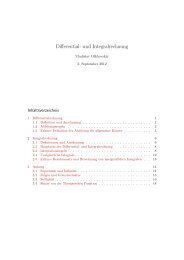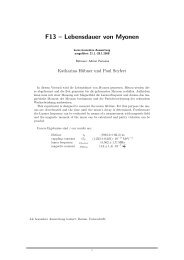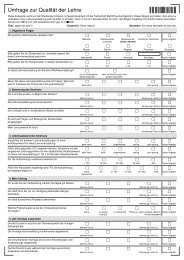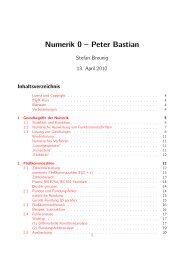Extrasolar Moons as Gravitational Microlenses Christine Liebig
Extrasolar Moons as Gravitational Microlenses Christine Liebig
Extrasolar Moons as Gravitational Microlenses Christine Liebig
Create successful ePaper yourself
Turn your PDF publications into a flip-book with our unique Google optimized e-Paper software.
CHAPTER 2. GRAVITATIONAL LENSING 11<br />
where the impact parameter<br />
u = β<br />
is used, the angular separation of the source from the point m<strong>as</strong>s in units of the<br />
Einstein angle. The magnification of the image inside the Einstein ring is formally<br />
negative, because it h<strong>as</strong> negative parity. It is a mirror-inverted image of the source.<br />
The sum of the two magnifications is unity,<br />
θE<br />
µ1 + µ2 = 1,<br />
but the net magnification of the source flux in the two images is obtained by adding<br />
the absolute magnifications<br />
µ = |µ1| + |µ2| = u2 + 2<br />
u √ u 2 + 4 .<br />
If the source is located at an angular separation of one Einstein radius from the lens,<br />
the impact parameter will become u = 1 and the total magnification<br />
µ = 3<br />
√ 5 = 1.34.<br />
If the source moves closer towards the lens, the magnification will incre<strong>as</strong>e (figure<br />
2.3). For β → 0 it reaches infinity. In reality, this is prevented by the finite extent<br />
of the source. The magnification is converted into units of magnitudes via<br />
mag = −2.5 log 10 µ. (2.6)<br />
According to the <strong>as</strong>trophysical convention, more negative values denote brighter<br />
luminosity.<br />
2.2.1 Triple-Lens Equation<br />
Planetary systems have the characteristic trait of being multiple lens systems. After<br />
having described the single-lens c<strong>as</strong>e in the l<strong>as</strong>t section, we ought to have a look<br />
at how multiple lenses manifest themselves in light curves and how they can be<br />
accounted for in the lens equation.<br />
Using complex coordinates, let us express the projected source position <strong>as</strong> η and<br />
the image position <strong>as</strong> ξ. For N point m<strong>as</strong>ses the lens equation then becomes<br />
η = ξ +<br />
N qi<br />
, (2.7)<br />
ξi − ξ<br />
i=1<br />
following Witt (1990) and also referring to Gaudi et al. (1998). ξi denotes the<br />
position of lens i. qi is the m<strong>as</strong>s ratio between lens i and the primary lens (qi = Mi<br />
M1 ).










